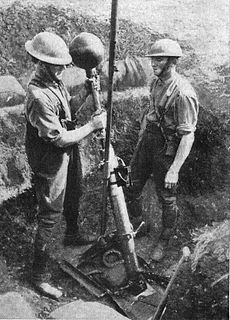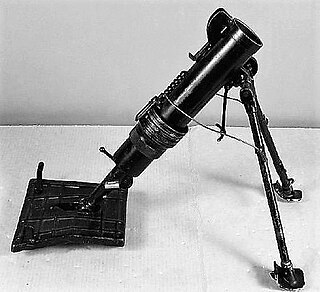 W
WThe 2 inch medium trench mortar, also known as the 2-inch howitzer, and nicknamed the "toffee apple" or "plum pudding" mortar, was a British smooth bore muzzle loading (SBML) medium trench mortar in use in World War I from mid-1915 to mid-1917. The designation "2-inch" refers to the mortar barrel, into which only the 22-inch bomb shaft but not the bomb itself was inserted; the spherical bomb itself was actually 9 inches (230 mm) in diameter and weighed 42 lb (19 kg), hence this weapon is more comparable to a standard mortar of approximately 5-6 inch bore.
 W
WThe 5 cm FlaK 41 (Flugabwehrkanone 41) was a German 50 mm (2.0 in) anti-aircraft gun produced for defending the intermediate zone above the range of light guns, but below the ceiling of the heavy pieces. The gun proved inadequate and was produced only in small numbers.
 W
WThe 5 cm leichter Granatwerfer 36 was a light mortar used by Nazi Germany during World War II.
 W
WThe 5 cm KwK 38 L/42 (5 cm Kampfwagenkanone 38 L/42) was a German 50 mm calibre cannon used as the main armament of variants of the German Sd.Kfz. 141 Panzerkampfwagen III medium tank during the Second World War. There was no towed anti-tank gun equivalent.
 W
WThe 5 cm KwK 39 L/60 (5 cm Kampfwagenkanone 39 L/60) was a German 50 mm calibre tank gun used during the Second World War, primarily as the main armament of later models of the German Panzer III tank from December 1941 onwards. It was produced when the well-armoured T-34 and KV-1 tanks were encountered in ever increasing numbers on the Eastern Front, although it was only partially successful in its role. It was later superseded by the 7.5 cm KwK 40 L/43.
 W
WThe 5 cm Pak 38 (L/60) was a German anti-tank gun of 50 mm calibre. It was developed in 1938 by Rheinmetall-Borsig AG as a successor to the 3.7 cm Pak 36, and was in turn followed by the 7.5 cm Pak 40. Note the unique curved gun-shield design which differs from most WWII anti-tank guns which have either one flat or two angled and one flat gun-shield plates for ease of manufacturing.
 W
WThe Rheinmetall Bordkanone 5, or BK-5, was a WWII-era German 50 mm autocannon primarily intended for use against Allied heavy bombers, such as the United States Army Air Forces's (USAAF) Boeing B-17 Flying Fortress. The shells had a high muzzle velocity and significant kinetic energy, allowing them to be fired from distances outside the range of the bombers defensive guns. The large explosive content of each shell almost ensured the destruction of any bomber that was hit.
 W
WThe Lance Grenades de 50 mm modèle 37 was a French light infantry mortar designed and produced shortly before the Second World War.
 W
WThe M-19 Maschinengranatwerfer is a German 50 mm mortar which was used during World War II. The mortar was developed in 1934 for the purpose of defending permanent military bases. It had a maximum rate of fire of 120 rounds per minute and a range of 750 metres.
 W
WThe RM-38 was a Soviet 50 mm light infantry mortar. The barrel was clamped at two elevation angles only - 45 and 75 degrees. Range variations were made by altering a sleeve round the base of the barrel. This sleeve opened a series of gas ports which bled off exhaust gases and so determined the range.
 W
WThe Type 89 Grenade Discharger , inaccurately and colloquially known as a knee mortar by Allied forces, is a Japanese grenade launcher or light mortar that was widely used in the Pacific Theater of World War II. It got the nickname the "knee mortar" because of an erroneous Allied belief that these launchers could be fired by propping its plate against the leg. However, anyone trying to fire it this way would receive a severe bruise from its hefty recoil.
 W
WThe XM913 is an experimental American chain gun produced at Picatinny Arsenal. The cannon is a larger and more modern version of the 25 mm Bushmaster cannon. Although its shells, 50 x 228 mm, are twice the diameter of the 25mm M242 Bushmaster, the 50mm cannons is not much longer than the smaller weapon. The overall lengths of the 25mm cannon and 50mm cannon are 105.2 centimetres (41.4 in) and 157.7 centimetres (62.1 in), respectively; while the portion of the gun that intrudes into the turret are 30.0 centimetres (11.8 in) and 40.1 centimetres (15.8 in), respectively.